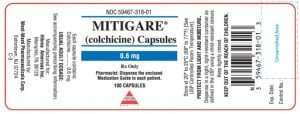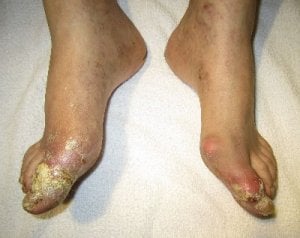Managing gout needs more than drugs explains things you must consider beyond pills. Because experts now agree that:
- Education must be part of your gout treatment.
- You must discuss your progress towards gout recovery regularly.
Then you will be better at stopping gout.
Therefore, this page is useful to all gout sufferers. Although these new findings come from medical studies, they affect all gout treatments. So, they are just as important if you chose herbal gout medicines. Or, lifestyle changes for gout control.
Managing gout needs more than drugs
In this review, I look at gout studies that look beyond gout drugs.
Firstly, I review a study of a new way experts plan gout control. Then, I show a timeline of related studies. Because they confirm and improve early findings. Finally, I explain how you apply these findings to your gout plan.
Gout Care Timeline
I searched PubMed for gout nurse ((“gout”[MeSH Terms] OR “gout”[All Fields]) AND (“nurses”[MeSH Terms] OR “nurses”[All Fields] OR “nurse”[All Fields])). Then I focused on studies that included schemes of gout patient care involving nurses. Also, I ignored studies with no abstract available and restricted my reviews to the English language. Then, I searched Google Scholar for (gout AND “package of care”).
Next is my review of the results in a timeline:
2012: The need for Gout Care
There is a link between the first 2 studies. Because both have a common co-author. So this first report looks at the need for a package of care for gout patients:
first phase of the Nottingham Gout Treatment Trial. Which aims to develop a practical complex intervention (package of care) for patients with gout. And to test its efficacy and cost-effectiveness in primary care.
Spencer March 2012[1].
Before, the phrase has been used in general rheumatology. But, never applied specifically to gout. So this study forms the basis of a practical treatment plan. Then with its follow-up in 2017, it gives more than drugs. However, as a combined body of work, this deserves a more thorough review. Therefore, I will publish a separate review linked to this timeline. Please complete the form below. Then, I will notify you when I publish more about the package of gout care.
2012: Package of Gout Care
Next, the second study of gout patients looks at the effects of applying packaged gout care. Because typical gout treatment gets success in 60 patients from 145[4]. So, they want better:
A predominantly nurse-led intervention including education, lifestyle advice and ULT can successfully achieve the recommended treatment target in more than 9 out of 10 patients. Full explanation and discussion about the nature of gout and its treatment options and individualization of management probably account for this success.
Rees – Jun 2012[2].
The significant parts of this package of gout care are:
- Talk and tests with a gout expert.
- Note site and size of tophi.
- Optional uric acid crystal test.
- Learn about:
- Causes of gout.
- Gout’s known risk factors.
- Consequences, including joint damage.
- Individual ways to control uric acid. Such as weight loss for obese gout patients.
- Discuss personal fears, goals, and potential treatments.
- Agreed individual gout control plan.
- Gout information leaflet.
- Nurse-led 20 minute follow-up by telephone. Or in-person, as set by individual needs.
So, 9 out of 10 success rate is good. Because typical success rates are 3 or 4 out of 10 gout patients.
2013: Managing gout needs more than drugs
This 2013 report is mainly a review of the 2012 gout studies[3]. But, it puts that UK research into a global view. Because it brings the context of professional rheumatology guidelines. So, this 2013 review starts current emphasis on “package of care” in professional gout guidelines.
2017: 5 Year Gout Package Follow-up
In the 2012 study reported above, gout patients had one year of nurse-led “package of care”. Then, they continued to be treated by their own doctor. So this study looks at compliance and success rates 5 years on. In detail:
- 90.7% of patients kept up with uric acid lowering treatment.
- The authors believe this could have been higher if “package of care” had continued beyond the first year.
- 86.4% had uric acid below 6mg/dL.
- 69.7% had uric acid below 5mg/dL.
In conclusion, this study demonstrates that an initial package of care that includes individualized education, patient involvement in management decisions and a treat-to-target approach to ULT results in the best long-term ULT adherence and persistence reported thus far. Such treatment may be initiated by a suitably trained nurse. Or by any other allied health care professional. Such as a community pharmacist.
Abhishek, April 2017[5].
2017: Gout Care and Education
The latest research into poor gout patient outcomes is promising. Because it suggests that nurse-led or pharmacist-led programs can improve American gout patient management[6].
The report lists several physician and patient factors that reduce gout treatment effectiveness. Then it suggests potential improvements.
- Physician Failings
- Identified failings of physicians include:
- Ignoring professional rheumatolgist’s guidelines.
- Inadequate uric acid testing.
- Uric acid target levels too high.
- Insufficient gout training.
- Lack of joint fluid testing.
- Under-dosing uric acid lowering drugs, usually due to failure to titrate treatment to achieve target.
- Patient Adherence
- Reasons identified for lack of patient compliance to prescribed uric acid lowering treatments include:
- Increased gout flares from uric acid lowering.
- Fear of side-effects.
- Lack of information
- Age – older gout patients are more compliant.
- Forgetfulness.
- Cost.
- Recomended Improvements
- Potential interventions to improve medication adherence include:
- Gout pain prevention during uric acid lowering debulking.
- Frequent follow-ups.
- Nurse-led or pharmacist-led education programs.
Gout Management Techniques Summary
To summarize, we see growing evidence to support introducing gout care packages. Furthermore, the “package of care” is now creeping into official gout guidelines:
Attention had been drawn to a range of patient and provider barriers to effective care. And a preliminary proof of principle study had demonstrated that these barriers could be overcome, and outcomes improved. With better provision of information and a package of care based on guideline recommendations.
EULAR 2016 Gout Guidelines Update[7].
Statement of potential organizational barriers to introduction
Despite the increasing prevalence of gout and the availability of effective and potentially curative ULT for >50 years, its management remains poor with only 40% of patients with gout ever receiving ULT. Inadequate provision of information to patients has been identified as one of the key barriers to effective management of gout. There is preliminary evidence that patient adherence to ULT and lowering of sUA to target levels can be achieved. With better provision of information and a package of care based on guideline recommendations.
Effective provision of information and monitoring of treatment to achieve target sUA levels requires regular ongoing clinical review. However, anecdotal reports suggest that some secondary care organizations prohibit follow-up of patients with gout. Insisting on discharge with a treatment plan to primary care where treatment is known to be suboptimal. Although 20% of people presenting with their first attack will have a second episode within 12 months, patients often do not consult for subsequent attacks. So, practitioners may not be aware of recurrent attack frequency and the need for ULT. Highlighting the case for discussing ULT early in the course of the disease.
British 2017 Gout Guidelines Update[8].

Your Gout Management Techniques
Now that you understand the importance of ‘package of care’ for gout, make sure it is included in your gout plans.
Firstly, approach your doctor, pharmacist, nutritionist, herbalist or whoever is in control of your gout management. Then, see what services they provide. But, you will probably find they do not offer such services. So, let me help you organize a scheme with your healthcare people. Just ask for help in the gout forum.
Finally, I’m publishing more resources about Gout Care Packages. So to stay up-to-date, please subscribe to my free update service:
Leave Managing gout needs more than drugs to browse more Resources for Gout Sufferers.
Gout Management Techniques References
All gout studies referred to in this timeline are available on the Internet at the time of publication. So, you can find them using GoutPal’s Google Gout service.
- Spencer, Karen, Alison Carr, and Michael Doherty. “Patient and provider barriers to effective management of gout in general practice: a qualitative study”. Annals of the rheumatic diseases 71.9 (2012): 1490-1495.
- Rees, Frances, Wendy Jenkins, and M. Doherty. “Patients with gout adhere to curative treatment if informed appropriately: proof-of-concept observational study”. Annals of the rheumatic diseases (2012): annrheumdis-2012.
- Lioté, F., and H. Choi. “Managing gout needs more than drugs:’Il faut le savoir-faire, l’Art et la manure'”. Annals of the rheumatic diseases 72.6 (2013): 791. (It takes the know-how, the art, and the way).
- Roddy, Edward, Weiya Zhang, and Michael Doherty. “Concordance of the management of chronic gout in a UK primary-care population with the EULAR gout recommendations”. Annals of the rheumatic diseases 66.10 (2007): 1311-1315.
- Abhishek, Abhishek, et al. “Long-term persistence and adherence on urate-lowering treatment can be maintained in primary care—5-year follow-up of a proof-of-concept study”. Rheumatology 56.4 (2017): 529-533.
- Aung, Thanda, Gihyun Myung, and John D. FitzGerald. “Treatment approaches and adherence to urate-lowering therapy for patients with gout”. Patient preference and adherence 11 (2017): 795.
- Nuki, G., M. Doherty, and P. Richette. “Current management of gout: practical messages from 2016 EULAR guidelines”. Polish archives of internal medicine 127.4 (2017): 267.
- Mallen, Christian D., et al. “Improving management of gout in primary care: a new UK management guideline”. Br J Gen Pract 67.659 (2017): 284-285.
Please give your feedback
Did this page help you? If yes, please consider a small donation. Your donations help keep GoutPal's gout support services free for everyone.
If not, please tell me how I can improve it to help you more.
- YouTube
- The gout forums.









